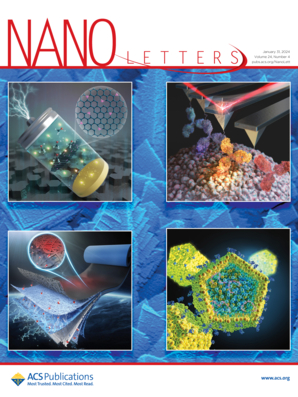Origin of Interlayer Exciton–Phonon Coupling in 2D Heterostructures
IF 9.1
1区 材料科学
Q1 CHEMISTRY, MULTIDISCIPLINARY
引用次数: 0
Abstract
The coupling between excitons and phonons across adjacent layers has been experimentally observed in various heterostructures of layered materials. However, the precise mechanism underlying this phenomenon remains elusive. Using the WSe2@hBN heterostructure as an example, we study the origin of the interlayer exciton–phonon coupling and its signature in resonant Raman scattering through first-principles calculations. Our study emphasizes the central role of crystal symmetries in the interlayer exciton–phonon scattering processes, which are responsible for the anomalous resonant Raman intensities of the in-plane and the out-of-plane hBN phonon modes. We find that the deformation potential induced by the hBN phonon interacts with the hybridized hole density of WSe2 excitons near the hBN interface, leading to interlayer exciton–phonon coupling.

二维异质结构层间激子-声子耦合的起源
在各种层状材料的异质结构中,人们通过实验观察到了相邻层间激子和声子之间的耦合。然而,这种现象背后的精确机制仍然难以捉摸。我们以 WSe2@hBN 异质结构为例,通过第一原理计算研究了层间激子-声子耦合的起源及其在共振拉曼散射中的特征。我们的研究强调了晶体对称性在层间激子-声子散射过程中的核心作用,它是造成面内和面外 hBN 声子模式异常共振拉曼强度的原因。我们发现 hBN 声子诱导的形变势与 hBN 接口附近 WSe2 激子的杂化空穴密度相互作用,导致层间激子-声子耦合。
本文章由计算机程序翻译,如有差异,请以英文原文为准。
求助全文
约1分钟内获得全文
求助全文
来源期刊

Nano Letters
工程技术-材料科学:综合
CiteScore
16.80
自引率
2.80%
发文量
1182
审稿时长
1.4 months
期刊介绍:
Nano Letters serves as a dynamic platform for promptly disseminating original results in fundamental, applied, and emerging research across all facets of nanoscience and nanotechnology. A pivotal criterion for inclusion within Nano Letters is the convergence of at least two different areas or disciplines, ensuring a rich interdisciplinary scope. The journal is dedicated to fostering exploration in diverse areas, including:
- Experimental and theoretical findings on physical, chemical, and biological phenomena at the nanoscale
- Synthesis, characterization, and processing of organic, inorganic, polymer, and hybrid nanomaterials through physical, chemical, and biological methodologies
- Modeling and simulation of synthetic, assembly, and interaction processes
- Realization of integrated nanostructures and nano-engineered devices exhibiting advanced performance
- Applications of nanoscale materials in living and environmental systems
Nano Letters is committed to advancing and showcasing groundbreaking research that intersects various domains, fostering innovation and collaboration in the ever-evolving field of nanoscience and nanotechnology.
 求助内容:
求助内容: 应助结果提醒方式:
应助结果提醒方式:


